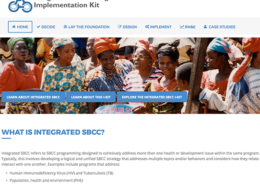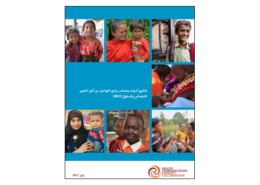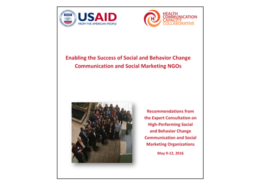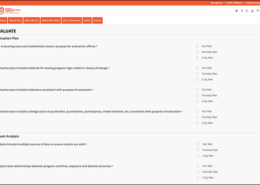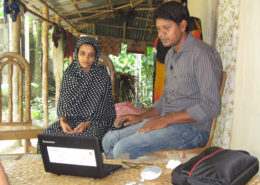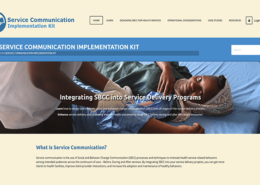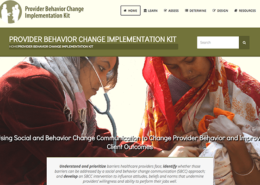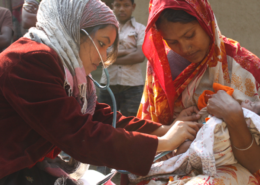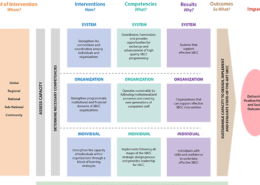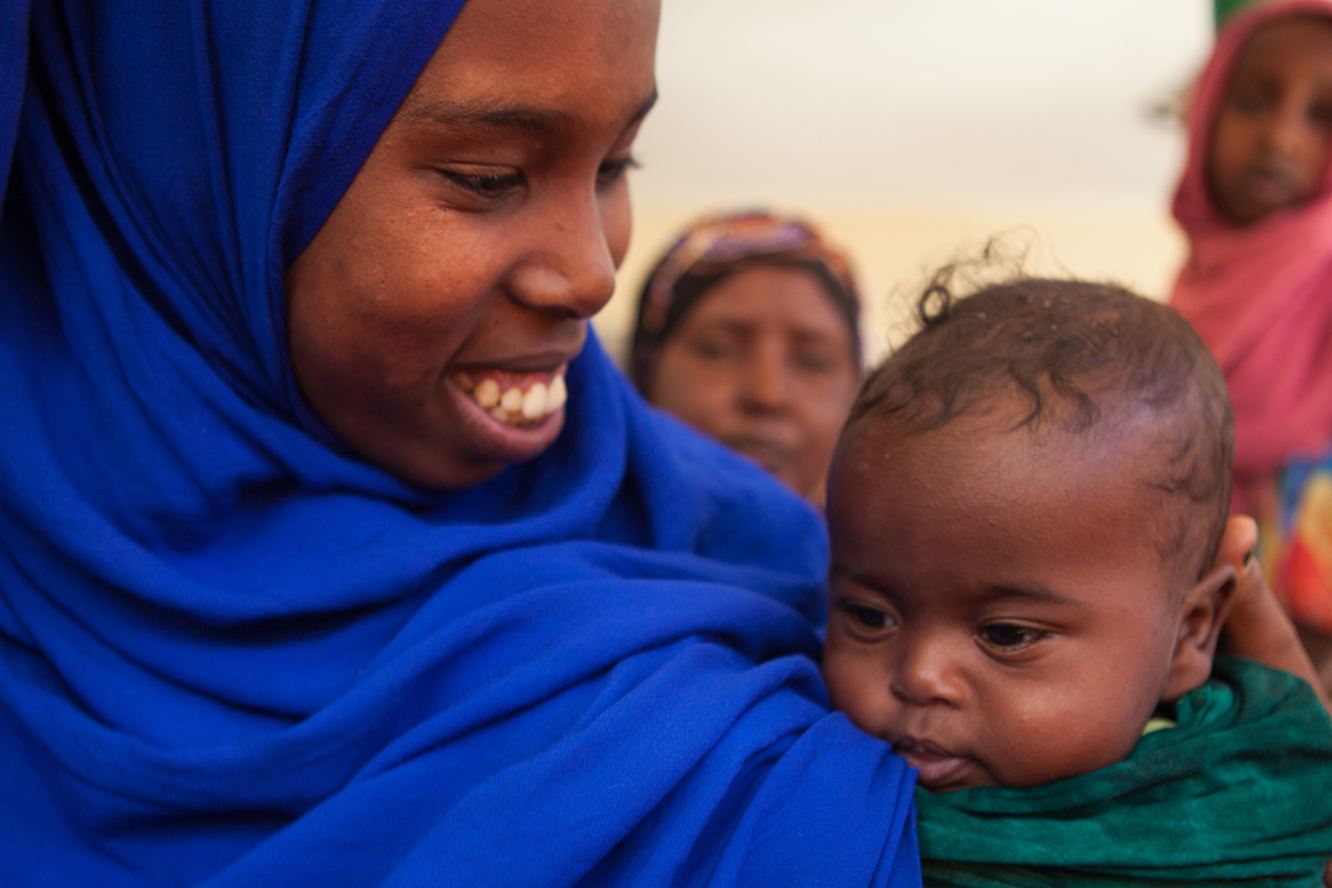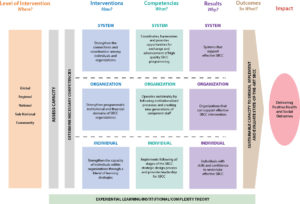
The SBCC Capacity Ecosystem™, a model developed by the Health Communication Capacity Collaborative for SBCC capacity strengthening.
As USAID’s flagship social and behavior change communication (SBCC) project from 2012 to 2017, the Health Communication Capacity Collaborative (HC3) had a mandate to serve the global SBCC community. That community includes SBCC organizations, service delivery organizations that integrate SBCC into their programs, government partners responsible for oversight of health education and health communication, journalists, universities, advertising agencies and a full range of SBCC practitioners from the novice to the expert.
Strengthened Global SBCC Capacity
Collected and Shared Resources
HC3 actively sought out outstanding SBCC tools and project materials and made them available through the Health COMpass. On the Health COMpass, campaign resources are grouped together and link to the original website of the producing organization, thus serving as a gateway to the larger SBCC community and increasing the visibility of our colleagues worldwide. The Health COMpass highlights the SBCC community’s achievements and contributions with SBCC Spotlights – real-life examples of how a successful SBCC campaign is designed, implemented, monitored and evaluated – and Trending Topics – topical collections of key resources that address priority SBCC – related information needs, such as Ebola or information and communication technology. More than just an online library, the Health COMpass is an easy-to-use learning site for SBCC professionals seeking to strengthen their own or others’ SBCC capacity.
Connected the SBCC Community
HC3 developed Springboard for Health Communication, an online space for sharing SBCC knowledge, experiences and resources. It connects communities of SBCC practitioners, scholars and policymakers, reinforced by face-to-face forums around the globe. Webinars, social media and blog posts inspired conversation and brought new ideas and information to the SBCC community.
New Resources to Move SBCC Forward
Playing close attention to what was missing, HC3 delivered what the SBCC community needed. Our own resources range from the basics, such as the SBCC How-to Guides – online resources that guide the user step-by-step through the fundamentals of the SBCC process – to higher-level health technical resources, such as HC3 Implementation Kits – online manuals for developing an SBCC strategy for health technical topics, such as the Healthy Timing and Spacing of Pregnancies, and SBCC and Gender. HC3 teams in Family Planning, HIV/AIDS, Maternal, Newborn and Child Health, and Infectious Disease developed priority health technical resources, such as the online Comprehensive Youth Sexuality Teacher Training course and the Malaria Behavior Change Communication Indicator Reference Guide.
Reinforced University Capacity
Through the University Needs Assessment, HC3 mapped the current academic field of health communication in low- and middle-income countries. We facilitated capacity strengthening through an expert SBCC community of practice on Springboard, webinars and internships with SBCC organizations for local university students to bridge the gap between academia and practice, and to share best practices in SBCC.
Tools for Assessing Capacity
HC3 developed high-quality capacity assessment tools, including the PROGRES_SBCC and SBCC Mapping tools, which serve to identify priorities for capacity building and measuring changes in organizational capacity overtime. The capacity assessment process was a cornerstone of HC3 – both establishing a baseline for programmatic capacity planning and allowing an SBCC organization to identify goals for overall organizational sustainability, as well as developing an approach to assessing national SBCC capacity. Additionally, HC3 developed a suite of resource mobilization tools aimed at fostering institutional sustainability and self-sufficiency.
Built SBCC Leadership Capacity
Our commitment to integrate organizational development with SBCC was highlighted by the SBCC Virtual Leadership Development Program – a blended learning program where participants work in teams to identify and address key SBCC leadership challenges within their organization. HC3 brought management and leadership training to 38 organizations working on SBCC projects in 17 countries. HC3 also worked with leaders and managers of SBCC organizations to develop Business Cases and full business plans to seek funding for new products and/or services that can be offered at a low cost and overtime generate revenue for the organization. This type of capacity strengthening allows for more creativity and freedom, business opportunity ideas are driven by perceived market demands, rather than foundation or donor interests.
Evidence for SBCC
As a capacity strengthening project, HC3 provided our global partners with the evidence they needed to design the most effective SBCC interventions and to advocate for SBCC. HC3 both gathered and reviewed the existing evidence and made it available in easy-to-understand formats, as well as generated new evidence, including two special journal supplement in the Journal of Acquired Immune Deficiency Syndromes (JAIDS) including 13 original articles.
HC3 Field Support Programs
USAID Missions had two key SBCC priorities:
- To implement impactful programs in pressing health areas, such as family planning, malaria, HIV/AIDS or Ebola.
- To build in-country capacity for SBCC design, implementation and evaluation.
HC3 responded to these needs by designing programs that strategically combine implementation with capacity strengthening. We creatively weaved an approach designed to the specific context that optimally leveraged local resources.
 HC3 Field Support programs followed a systematic Capacity Improvement Cycle. First, a capacity assessment is implemented. Based on the results, a capacity strengthening plan is developed, implemented and monitored. Progress is assessed at regular intervals and the program is adjusted accordingly. Our programs combined three approaches for maximum impact: Direct Capacity Strengthening, Collaborative Implementation and Systems Reinforcement, tailored to the needs of the country context.
HC3 Field Support programs followed a systematic Capacity Improvement Cycle. First, a capacity assessment is implemented. Based on the results, a capacity strengthening plan is developed, implemented and monitored. Progress is assessed at regular intervals and the program is adjusted accordingly. Our programs combined three approaches for maximum impact: Direct Capacity Strengthening, Collaborative Implementation and Systems Reinforcement, tailored to the needs of the country context.
Direct Capacity Strengthening
Strategically blending a mix of methods, HC3 assisted partners in reaching their goals for capacity strengthening in SBCC and organizational development. Methods included coaching, seconding advisors, facilitating internships, fellowships, providing other professional development opportunities, providing links to external resources and tools, e-learning and training, among others. There was a focus on experiential learning. Our field teams worked with partners on current SBCC activities so capacity strengthening is applied on the job for the greatest impact. The wealth of HC3 global resources were made available to reinforce in-country capacity strengthening.
Collaborative Implementation
Our teams worked closely with local partners in the development and implementation of an SBCC campaign, drawing on their experience and expertise. In the mapping of the campaign, we strategically weaved in capacity strengthening activities – mini-workshops, in-service trainings, review of tools and resources, and reflection meetings – so project based learning is explicit and systematic. According to adult learning theory, adults learn best both through hands-on experience and an opportunity to reflect on the experience. We reinforced learning by Preparing for an activity, Doing the activity, Reflecting on the activity and Adapting the activity (PDRA).
Systems Reinforcement
Working with missions, governments and local partners, we identified gaps and pinpointed high-priority, high-impact activities that benefit the larger system for SBCC in the country. Activities ranged from establishing technical working groups, SBCC communities of practice and coordination committees to developing criteria for SBCC programs and materials, and collaborating on national-level strategies.


